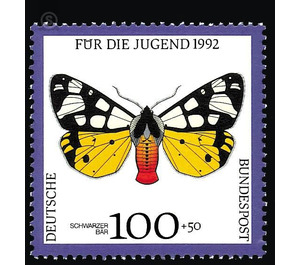youth: endangered moths - Germany / Federal Republic of Germany 1992 - 100 Pfennig
Theme: Animals
| Country | Germany / Federal Republic of Germany |
| Issue Date | 1992 |
| Face Value | 100.00 |
| Color | multi-colored white blue |
| Perforation | K 13 3/4 |
| Printing Type | Multicolor offset printing |
| Stamp Type | Postage stamp |
| Item Type | Stamp |
| Chronological Issue Number | 1478 |
| Chronological Chapter | GER-BRD |
| SID | 501040 |
| In 32 Wishlists | |
Whoever speaks of butterflies usually means the colorful, flower-visiting butterflies that fly in the sunshine during the day, such as the peacock's eye, the little fox or the cabbage white. Few know that about nine-tenths of all butterflies belong to the so-called "moths." However, this is a rather inaccurate (and unscientific) collective term that encompasses everything that is not just "butterflies", a vast, heterogeneous set of at least 150,000 species worldwide, to which about 60 different "families" are assigned (for comparison: butterflies, for example) 13,000 species, 5 families). The only thing they have in common is their nocturnal way of life (and even that is far from being the case in every species, as many have become diurnal again). The fact that they fly around at night, being lured by light sources and sometimes getting into apartments, is probably the main reason why this large group of insects has either remained largely unknown to the layman or even occasional encounters with these "moths" are considered unpleasant, though they are completely harmless. Hardly anyone knows, therefore, the splendor and beauty of many species, at least comparable to the butterflies, or the subtle aesthetics of the other, less conspicuously colored species. There are more than 2,000 species of moths in Germany and of course they are - as well as the butterflies - endangered by human interference in the natural environment and threatened in part their existence. That they, too, are an indispensable and worthy part of a whole, to which, last but not least, man belongs, is to draw attention to the small selection of native moths. The Black Bear (Arctia villica), a very heat-loving species, has been disappearing from many areas for decades. It is regularly found in the Rhine-Moselle region and in northeastern Germany (Mecklenburg, near Berlin, in warm, dry sand heath areas). The dark brown hairy caterpillar is easily recognizable by its red head and the same colored breastbones. It lives from August - overwintering - until May and feeds on various lower plants, such as dandelion, sorrel, plantain and deadnettle. The pupation takes place in a gray web on the ground. The moth flies in June and July. In the Rhine-Moselle area, this species prefers the vineyards, abandoned plants are ideal habitats. Hazard factors: In the northeast of the area destruction of heathland by afforestation or agricultural use (maize cultivation). In cultivated vineyards no possibility of existence because of control of undergrowth by herbicides as well as insecticide employment. Abandoned plants are only an ideal habitat in the short term (change of microclimate through bush encroachment).


